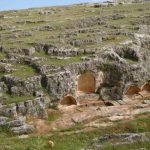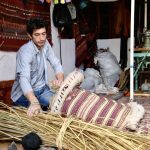There was a time when it was hard to find any information about tourist attractions in Turkey but the situation is improving rapidly now. Yesterday I’d been flicking through some leaflets while waiting for Rebecca and had seen mention of a Mor Petrus Paulus (Sts Peter and Paul) Syrian Orthodox church in Adıyaman. Heading towards the Ulu Cami we’d even seen a sign to it but one that clearly said that it was “kapalı (closed)”. Ever hopeful, we decide to have one last quick look for it and, sure enough, here it is, tucked away in a residential district into which no visitor would normally stray.
It’s an austere box of a building constructed of Urfa stone and with tiny oval cutouts above the portico that remind me of Mardin. It’s not even particularly old, having been built in 1883 and then destroyed in the chaos after the First World War. But the mere fact that it exists at all interests me. I’ve made plenty of previous visits to this particular area without ever hearing about it before even though it turns out to be the seat of a bishopric. Now it seems that we’ve arrived just as it’s being brought back to life again.
The courtyard is fenced off and men are hard at work building a brand new rectory at right angles to the church. We step gingerly across the rubble, hoping to snap a quick picture and make off before someone comes to tell us it’s yasak (forbidden). Then suddenly a young man is walking towards us all smiles and welcomes, and soon the door is being unlocked and we’re being led inside.
I don’t know quite what I was expecting but it certainly wasn’t this – a spotlessly clean church full of wooden pews that makes it look like just like a church from the UK, except that this one has a stepped altar surrounded by woodwork painted mustard yellow and lapis lazuli. The young man who had welcomed us is keen to show us the Bible in what looks like Arabic but is in fact Syriac, or rather Kthobhonoyo, the formal written version of Syriac, a language evolved from the Aramaic believed to have been spoken by Jesus. He also points out the alpha and omega in Syriac that occupy the top corners of the altar frame. The church is obviously newly restored, work that took eighteen months according to Hurriyet Daily News which also reports that the church is now used by all Christians in the area rather than just by the Suriyanis
On the way out we pause to snap the benches in the porch which are inscribed in Syriac and to take a sneaky peek at the bishop responsible for the restoration who is chatting to the workmen in a corner. He wears the dramatic black headdress decorated with 12 crosses of the Syrian Orthodox tradition and I’m itching to butt in and talk to him. Still, I feel very privileged to have had this quick glimpse at something that might suggest a welcome thawing of relations between the Turkish state and the Suriyani community.
But now it’s time to move on. We’re heading for Mt Nemrut which means that we need to get to Kahta today. The skies are clearing, an encouraging sign since guests at the hotel had described having to visit the great Commagene heads in the midst of yesterday’s downpour. The snag is that we can’t quite work out where to pick up the bus to Kahta, something one might have thought would be a no-brainer. We ask at the otogar and get directed to a desolate street corner where a succession of suitably stuffed dolmuşes to Kahta pass by and leave us standing. I try asking the drivers where they start their route but they’re so sure that I’m a “tourist” that no matter what I say in Turkish they refuse to discuss the matter with me and address their replies instead to random men who are trying to help us. I don’t know how many dolmuşes pass before eventually we work out that we need to backtrack to the hotel and catch the Kolej bus to the köy garaj.
Ah, Kahta. What to say about this singularly charmless town which is little more than one long straggle of ugly, mismatched concrete buildings. I’ll be honest. I’ve not had good experiences here in the past which means that I’ve arrived here predisposed to be dismissive. It’s true that the passing of time means that most of the erstwhile half-built structures are now complete. On the other hand the road that strikes north for Nemrut is being widened which means dust everywhere.
What do I remember of the Kahta of the past? Well, I remember that you used to have to clamber on a stone to reach the pavement in front of the tourist office, and I remember cockroaches in my hotel bathroom, but mainly I remember the aggravation of being pursued along the street by people keen to sell me a tour who wouldn’t take no for an answer.
To be fair, things seem somewhat calmer now. We’ve been advised to try the Öğretmen Evi (Teachers’ House) as an alternative to the hotels partly on cost grounds but partly because we’ve set off on this trip without checking the calendar first which means that we’ve arrived here over a public holiday weekend when the world and his wife will be visiting Nemrut. The Öğretmen Evi is a fairly impressive building in a town virtually bereft of impressive buildings. The trouble is that it’s one of those old-style Turkish buildings that turns out to be all fur and no knickers. Dramatically curved on the outside, it has a reception area large enough to handle a whole Hilton of visitors. Unfortunately, the curved shape results in bedrooms that are shared like wedges of cheese. There’s nothing exactly wrong with my room but then there’s nothing much right about it either.
Rebecca is starving so we stop off for lunch in one of the few inviting restaurants. Then a little further along the road we stumble upon a bring-and-buy sale much like those you might find in England – except that this one is in Eastern Turkey which means strict sexual segregation for fear shoppers might, well, I’m not quite sure what really. Anyway, the women seem quite twittery and pleased to see us, and we snap up a few bits and pieces – a piece of crocheting for me, some children’s books in Turkish for Rebecca – then retreat outside to eat home-made cake washed down with boxed peach juice. It’s all a bit grim, what with the tarpaulin put up to ensure the men on the other side of the courtyard can’t see us but we’re still in the first few days of a trip mode and hardly notice.
Shortly afterwards Kahta trails out on us. Across the road we find a park which turns out to be the highlight of town mainly because it has a large pond in the centre, the perfect place to sit out of the sun. On the other hand a quick turn around the park reveals that women are not supposed to sit by the water. Instead they’re meant to sit in the far less inviting “aile (family)” area out of sight of it. But we’re stroppy foreign women and we want to sit by the water. So that’s precisely what we do and no one seems to bat an eyelid. Indeed someone quickly comes to rig up an umbrella so that we’ll be more comfortable.
From a previous visit I remember that there’s a nice fish restaurant beside the Atatürk Lake so we flag a taxi to take us there. It being Sunday lots of locals have assembled to picnic and a strong smell of grilling fish fills the air. While Rebecca is taking photographs I befriend a group who’ve brought half-a-dozen partridges down to the lake with them. They’re housed in paired wooden cages barely bigger than themselves which troubles me. On the other hand they seem bright-eyed, eager for titbits and very much part of the family. I sit down for tea and soon find a piece of fish being slipped across to me. The younger women can speak Turkish and one is even taking English classes. Their mother, on the other hand, speaks only the Kermanca dialect of Kurdish so everything I say must be translated for her benefit.
The lake itself is glorious in the late afternoon light but I’m made twitchy by the litter that fringes the water and will presumably be remaining there after the last picnicker and fisherman have packed up and gone home. As we sit down to dinner memories of the previous visit start to come back to me. I’d arrived here with the then manager of the tourism information officer and a lawyer who was acting for villagers who had lost their land to the lake. “Did they get compensation?” I asked him. “Yes, but it was derisory,” he said. “I’m trying to get them more.” Shortly after that I infuriated him by drawing parallels between the Turkish-Kurdish situation and the British-Irish one. It was quite a relief to get back to my cockroach-infested bedroom.
Written: 21 May 2011


